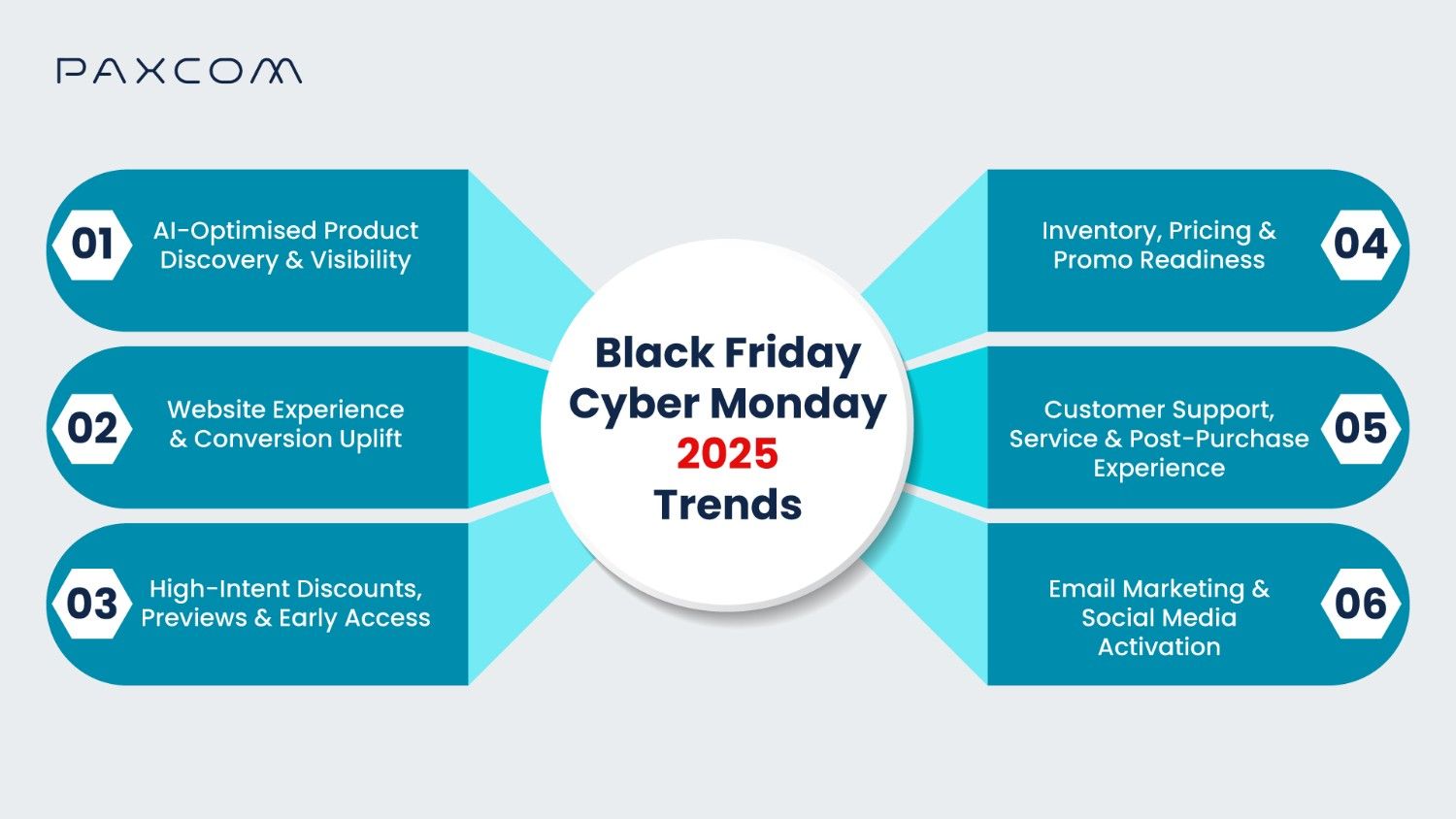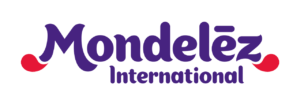Ever been stuck pumping budget into your Black Friday Cyber Monday campaigns and still seeing weak performance? You tweak keywords, adjust bids, refresh creatives, and yet the results barely move. You increase the budget hoping BFCM finally delivers — but the cycle repeats.
For eCommerce brands heading into Black Friday Cyber Monday 2025, this scenario is more common than you’d think. With rising ad costs, shifting shopper habits, and increased competition, simply “running campaigns” isn’t enough. Performance now depends on how well you optimize your BFCM 2025 marketing strategy, not how much you spend.
And optimization isn’t just about keywords or bidding mechanics. It includes multiple layers — creative testing, conversion funnels, landing page speed, email timing, audience segmentation, and increasingly, dayparting.
Dayparting has become a critical factor heading into peak season. In 2024, conversion rates peaked between 7 PM–10 PM local time, with 63% of purchases happening on mobile, clear signals that timing shapes performance. Smart advertisers used time-based bidding and scheduling to capture these high-intent windows, leading to stronger ROAS and reduced wasted spend.
As you build your BFCM preparation guide and plan your peak season eCommerce strategy for 2025, dayparting deserves a proper spot on your checklist.
Table of Contents
Black Friday, Cyber Monday 2024 Performance Recap
Before planning your Black Friday Cyber Monday 2025 strategy, it’s important to understand how shoppers behaved in 2024. BFCM continued to dominate global eCommerce, with record-breaking performance across mobile, marketplaces, and direct-to-consumer channels. These insights should guide your BFCM optimization plan, helping you align budgets, campaigns, and category expectations.
Global & U.S. Highlights
2024 proved that BFCM isn’t slowing down anytime soon.
- Global Cyber Weekend sales surpassed $70B, led by electronics, apparel, beauty, and home goods.
- In the U.S., Black Friday hit $9.8B (+7.5% YoY) and Cyber Monday reached $12.6B, marking the single largest online shopping day in history.
- Average discounts ranged from 25%–35%, with electronics hitting some of the steepest markdowns.
These numbers reinforce why a solid BFCM 2025 marketing strategy is vital for all eCommerce brands.
Changing Consumer Behavior
Shopping behavior in 2024 shifted even more heavily toward mobile and late-evening purchasing:
- 63% of all BFCM purchases happened on mobile, reflecting higher trust in one-click checkout experiences.
- 72% of shoppers waited specifically for BFCM deals, showing how price-sensitive and promotion-driven consumers have become.
These trends highlight the need to optimize bids, timing, creatives, landing pages, and mobile-first experiences for BFCM 2025.
Marketplace Performance
Marketplaces like Amazon, Walmart, and Flipkart saw significant momentum.
- Amazon sellers alone generated $9.8B during the BFCM period, driven by competitive pricing, early deals, and aggressive promotions.
- Fast-moving categories like tech accessories, beauty, and small appliances dominated search and click share.
For brands depending on marketplace sales, this reinforces the importance of BFCM product optimization, keyword strategy, and strong promotional positioning.
Why This Matters for BFCM 2025 Trends?

Every one of these insights feeds into the core question brands are asking:
“How do we prepare for Black Friday and Cyber Monday 2025 more effectively?”
Your strategy must be built around:
1. AI-Optimised Product Discovery & Visibility
Why it matters in 2025:
Search behaviour on marketplaces has fundamentally shifted. AI-led discovery (Amazon Rufus 2.0, Flipkart’s AI search enhancements, Google’s AI-generated shopping results) now prioritises semantic relevance, consumer intent, and content completeness over traditional keyword stuffing. This means your BFCM visibility depends on how well your product data speaks to AI systems.
What Brands Must Do
- Optimise for AI-intent searches
Today’s shoppers type full questions, not keywords. Update product titles, bullets, and backend terms to reflect the way people actually ask: problem-first, benefit-led queries. This helps your products appear for “solution searches” (e.g., best gifts under $50, fragrance-free lotion for dry skin). - Complete every product attribute
AI ranking systems deprioritise incomplete listings. Fill out 100% of attributes — size, material, compatibility, certifications, variants, and usage details. More attributes = more visibility across filters, comparisons, bundles, and AI-driven recommendations. - Upgrade A+ Content for AI summaries
AI extracts information from your A+ content to generate product highlights. Use clean design, short benefit-driven lines, and structured blocks. Add updated claims and comparison charts to help users (and AI) instantly understand why your product is better. - Strengthen Q&As and review signals
Q&As and reviews directly influence whether an AI recommends your listing. Answer recurring questions proactively, address negative patterns early, and encourage high-quality reviews. Better sentiment improves credibility, conversion, and AI-led visibility.
2. Website Experience & Conversion Uplift
With mobile-first shopping, AI-driven commerce, and tighter margins, every second and every interaction counts. In BFCM 2024:
- Retailers saw a +14.7% YoY traffic increase over the weekend.
- Mobile dominated: 80% of US traffic came from mobile devices, and 73% of the orders were placed via mobile.
These trends highlight that your site must be optimized not just for usability, but for urgency, AI-readiness, and mobile conversion.
What Brands Must Do
- Ensure lightning-fast, mobile-first performance
Optimize site speed for sub-2 second loads on mobile. Fix any checkout friction, broken links, or payment issues. - Simplify and unify the checkout journey
Enable one-tap or express payment (Google Pay, BNPL, etc.). Highlight delivery cut-offs for BFCM to drive urgency. - Build BFCM-dedicated landing experiences
Create holiday-specific landing pages like “Best BFCM Bundles,” “Gifts Under $50 / ₹2,000,” or “Limited-Time Black Friday Deals.” - Rework trust touchpoints
Update your policy copy, shipping, returns, guarantees to reflect BFCM demands. Show estimated delivery dates dynamically and reassure buyers around inventory.
Last-Minute Tip:
Run a pre-BFCM smoke test. One week before the weekend, simulate heavy traffic (~peak hours) on your site, or use load-testing tools. Identify bottlenecks in checkout, payment, and “add to cart” flows, then preemptively fix them so you don’t miss out when real demand peaks.
3. High-Intent Discounts, Previews & Early Access
Consumer behavior during BFCM has shifted. Shoppers no longer wait for the weekend — they track deals early, compare across channels, and expect tiered pricing. This makes structured, well-timed promotions more impactful than blanket discounts.
Based on BFCM 2024 behavior:
- 70% of global shoppers started browsing deals at least a week before Black Friday (Salesforce).
- Discounts averaged 29% globally, but categories like electronics and beauty touched 35–40% (Adobe).
Bundling worked extremely well — merchants offering bundles saw 52% higher AOV (Klaviyo). - Early Access contributed to nearly 1/3rd of total BFCM revenue for brands running private previews.
The takeaway?
Timing + relevance beats heavy discounting. Brands that structure their offer calendar win more conversions and protect margins.
What Brands Must Do
Design smart bundles and tiered savings to lift AOV
Bundles outperform standalone SKUs — especially when budgets are tight. Build bundle logic like:
- Starter Kits (entry-level buyers)
- Best-Selling Combos (proven conversion drivers)
- Stock-Up Packs (higher-margin repeat buys)
Structure offers such as:
- Buy 2, save 10%
- Buy 3, save 20%
- Gift combos under ₹1,499 / $25
This helps balance revenue growth with margin protection.
Prioritize Early Access: your highest converting lever
Give loyalty members, email subscribers, WhatsApp opt-ins, or app users:
- Early deal previews
- Exclusive SKUs
- Special discount tiers
- “24-hour head start” access
Early access not only boosts sales but also stabilizes demand before peak traffic hits.
Use psychological triggers to create urgency & scarcity
During BFCM, shoppers respond quickly to cues like:
- “Only X left”
- “Deal ends in 2 hours”
- “Nearly sold out”
- “Next price drop at midnight”
These encourage quicker checkout decisions and reduce cart abandonment.
Don’t forget hidden conversion boosters
Small perks can dramatically improve conversion during BFCM, such as:
- Free shipping above a threshold
- Free samples/products with select purchases
- Exclusive payment partner discounts (BNPL, UPI, wallets, cards)
- Cashback for repeat purchase in December
These reduce friction and keep the basket moving.
Last-Minute Tip:
Activate Early Access 24 hours before the sale.
Push it to email, app, and WhatsApp. Early access buyers convert 2.5x faster, and their cart value is typically 20–25% higher — a quick win if you’re running behind schedule.
4. Inventory, Pricing & Promo Readiness
Inventory gaps and pricing mismatches are the biggest silent revenue-killers during BFCM. With shoppers comparing prices across marketplaces, apps, and brand sites, even a minor stock discrepancy or promo mismatch can derail conversions. Brands that planned supply early and synchronized pricing across channels were the ones who captured the surge.
During BFCM 2024, many retailers reported:
- 18–22% sales loss attributed to out-of-stock or slow-moving inventory.
- Higher conversion for SKUs with matched pricing across platforms (Amazon, brand site, retail).
This reveals that inventory + pricing readiness isn’t a backend chore — it’s a conversion strategy.
What Brands Must Do
Audit top SKUs and ensure stock depth
Identify the 20% SKUs that drive 70–80% revenue.Make sure these products have:
- Sufficient buffer stock
- Accurate MOQ planning
- Safety stock for high-velocity days
Also unify inventory visibility across marketplaces, brand site, and warehouse to avoid overselling.
Fix pricing consistency across all channels
Consumers are hyper-aware of price variations during BFCM.
- Sync pricing and discounts across Amazon, brand site, Q-commerce, and offline.
- Resolve any MAP violations or unauthorized seller pricing drops.
- Ensure coupon stacking rules are clear to prevent payment-page abandonment.
Test promo logic early
Brands often discover coupon issues on the day of the sale.
- Test every promo: % off, BOGO, limited-time drops, cart threshold discounts.
- Check compatibility with wallets, BNPL, UPI, and gift card payments.
- Ensure promo banners match landing page logic.
Last-Minute Tip:
Do a 48-hour OOS sweep before BFCM goes live.
Identify SKUs with <10 days of cover and push them into bundles or time-limited flash deals. This prevents margin leakage and eliminates “wasted traffic” on unavailable products.
5. Customer Support, Service & Post-Purchase Experience
In BFCM 2024, customer service became a differentiator. With tighter delivery windows, higher cart values, and more first-time shoppers, brands that offered fast, multichannel support saw significantly higher repeat purchases even after the sale.
Key industry insights from 2024:
- 60% of customer queries during Cyber Week were delivery or order-status related.
- Brands with AI chatbots reported 40–55% resolution via automation, reducing load on human agents.
- Fast, proactive post-purchase communication increased repeat purchase probability by 27% in the following 30 days.
This isn’t just support, it’s a trust and retention engine.
What Brands Must Do
1. Diversify multichannel support (chat, WhatsApp, email, social)
BFCM traffic spikes mean queries come from everywhere.
- Integrate support across Instagram DMs, WhatsApp, site chat, and SMS.
- Prepare pre-built templates for common queries: delivery delays, payment failures, return policy timelines.
2. Deploy AI-first support for instant responses
During peak hours, instant answers = drop in cancellations.
- Use AI chatbots to handle FAQs, delivery updates, and product queries.
- Route complex cases to agents with full customer history.
- Enable order lookup via phone/email for frictionless resolution.
3. Strengthen post-purchase communication
Once the sale is over, the experience shouldn’t end.
- Send proactive shipping updates (“Your order is arriving a day early!”) alongwith direct tracking links.
- Add an educational insert or email: “How to use your new product,” “Care instructions,” “Warranty activation.”
- Share an easy single-click “Need help?” link.
4. Prepare for returns & exchanges load
Returns peak 7–14 days after BFCM. If brands don’t plan ahead, support queues explode.
- Update return windows, packaging rules, and refund timelines.
- Train agents with clear SOPs for festive return handling.
- Set up a simple self-serve return interface to reduce dependency on agents.
5. Build retention workflows post-BFCM
BFCM brings a surge of first-time shoppers — don’t let them drop off.
- Set up segmented email flows for:
- First-time buyers
- High-value customers
- Abandoned cart revisit messages
- Offer loyalty points, early access to New Year drops, or personalized recommendations based on purchase history.
Last-Minute Tip:
Create a “Crisis Response Playbook” for BFCM week and primarily focus on:
- fallback courier partners
- backup contact hours
- template responses
- escalation matrix
- proactive delay messaging
This saves hours during peak chaos and keeps CSAT high.
6. Email Marketing & Social Media Activation
During BFCM, inboxes and feeds become the most competitive real estate for brands. In 2024, shoppers leaned heavily on emails and social content to decide what to buy, especially for gift guides, last-minute deals, and bundle discoveries.
Key 2024 insights:
- Email drove 18–22% of total Cyber Week revenue for most mid to large brands.
- Social media–led discovery grew 31% YoY, driven largely by Instagram Reels, TikTok, and YouTube Shorts.
- Creators influenced up to 40% of Gen Z’s BFCM purchases.
- Cart recovery emails delivered a 6–8% conversion uplift when personalized.
Email = intent fulfillment; Social = intent creation.
Together, they make a high-conversion ecosystem.
What Brands Must Do
1. Build high-performing BFCM email sequences
Don’t depend on one sale announcement. Use a structured flow:
- Warm-up emails: tease wishlists, upcoming bundles, and VIP access.
- Sale live emails: highlight top SKUs, limited-time deals, and category spotlights.
- Cart recovery: add urgency (“Only 6 hours left,” “Price drop active now”).
- Last-chance reminders: final 2–3 hours push with “ending tonight” messaging.
Personalize using segment data — past purchases, preferred categories, site behavior.
2. Create social-first content that drives traffic + conversions
Lean into formats that performed best in 2024:
- 10–15 second Reels/Shorts with “bestsellers”, “top gifts”, “₹999 picks”, “Black Friday essentials”.
- Vertical videos showing real-time deal drops.
- Carousel posts highlighting bundles, before–after use cases, or value comparison.
- Festive-themed lifestyle shots for gifting categories.
Make the call-to-action clear: tap-to-shop, link in bio, or DM to order (for quick commerce–driven categories).
3. Activate influencers early
Even with short notice, creators help brands cut through the noise.
- Partner with micro-creators (10k–75k) for authenticity + fast turnarounds.
- Send them top-selling SKUs or bundles for unboxing videos or 1-minute review clips.
- Request UGC-style content to repurpose on ads, email headers, and landing pages.
This builds trust in categories where consumers seek validation (beauty, personal care, home appliances, electronics).
4. Sync messaging across email + social
Mixed messaging = confused buyers.
- Ensure banners, pricing, CTAs, and promo codes match across both channels.
- Align hero products across email newsletters and Instagram/TikTok Reels.
- Use similar copy lines during the main drop → “Lowest Prices of the Year,” “48-Hour BFCM Specials,” etc.
This consistency boosts recall and conversion dramatically.
Digital Shelf Analytics: A Strategic Imperative for Executive Control
Digital Shelf Analytics (DSA) is no longer a technical tool—it is a strategic asset that provides the operational rigor required to maintain market control and profitability. Effectively deploying DSA is crucial for mastering critical business drivers:
- Financial Risk Mitigation: Inventory visibility to eliminate stock-outs of high-demand SKUs, mitigating the significant financial risk of lost revenue and customer churn.
- Capital and Operational Planning: Leverage predictive analytics, derived from historical sales data and market research, to establish highly accurate demand forecasts, optimizing working capital and streamlining the supply chain.
- Competitive Positioning: Execute continuous analysis of competitor pricing and promotional trends to ensure agile and effective market positioning.
Kinator: The Strategic Engine for Accelerated Growth
Our proprietary DSA platform, Kinator, is designed to serve as your strategic engine, translating raw data into informed decision-making for superior inventory efficiency and accelerated revenue growth.
Kinator drives critical executive oversight through:
- Availability Assurance: Kinator tracks and alerts on-shelf availability across all platforms, sellers, and geographies. It flags promotional activity tied to unavailable inventory and isolates critical Power SKUs that are out-of-stock, directly safeguarding high-value sales.
- Marketplace Optimization: The platform tracks stock trends across all channels and categories over time, providing the data necessary for strategic resource allocation.
- Maximizing Customer Lifetime Value:
- Strategic Retargeting: By compiling comprehensive records of non-purchasing visitors and ad-click conversions, Kinator enables granular insight into the customer journey, facilitating highly effective retargeting strategies.
- Revenue Uplift: The system supports cross-sell and upsell recommendations during the checkout procedure to immediately increase order value.
- Brand Visibility: It enhances product visibility on your brand’s owned website by clearly displaying where products are listed, reducing stock levels, and driving sales by capturing new customers
Summing Up
BFCM is no longer a discount weekend, it has become a stress test for how well your entire commerce engine performs under pressure. The brands that led in 2024 weren’t simply offering the steepest deals; they were the ones operating with precision, tighter inventory discipline, faster websites, smarter media execution, and real-time decision-making across channels.
2024 made one thing clear:
Speed matters. Data clarity matters. Customer experience matters.
Going into 2025, BFCM success will demand a full-funnel strategy where performance marketing, conversion optimization, demand forecasting, and customer communication all work in sync.
And this is exactly where Paxcom strengthens a brand’s peak-season readiness.
With end-to-end campaign management, brands can execute performance, visibility, retargeting, and promotional strategies without operational lag. Digital Shelf Analytics ensures products stay discoverable, in-stock, competitively priced, and retail-ready throughout the surge. And with our GEO services, brands gain geographic-level insights that help them prioritize high-opportunity markets, tailor regional strategies, and maximize return in real time.
When these capabilities come together, BFCM becomes more than a revenue spike; it becomes a scalable, repeatable growth framework for the entire year.
The brands that prepare early, act with agility, and anchor decisions in data will not only win the BFCM weekend… they will own the months that follow.
Manage your backend operations flawlessly and effortlessly. Connect with us for more information at info@paxcom.net.
FAQs for BFCM 2025
The strongest BFCM 2025 strategy focuses on predictive planning, smarter retail media investments, and AI-assisted campaign optimization. Instead of discount-heavy tactics, brands are shifting toward experience-led Black Friday 2025 campaigns—using data signals, enhanced product pages, and faster checkout flows to capture intent.
Black Friday 2024 performance showed strong growth in both India and the US, driven by higher AOVs, earlier deal discovery, and better retail media ROAS. For 2025, this means brands must prepare for longer peak cycles, stronger competition on marketplaces, and evolving holiday shopping trends 2025 shaped by AI-driven discovery.
Key BFCM 2025 trends include AI-personalized deals, retail media expansion, real-time dynamic pricing, and digital shelf optimization becoming non-negotiable. Brands are leaning into first-party data, multi-touch attribution, and cross-channel holiday season campaigns to stay competitive.
Winning Cyber Monday 2025 strategies include optimizing high-intent segments, enhancing PDPs, deploying last-mile urgency messaging, and using insights from Black Friday 2024 performance to refine campaigns. Brands focusing on conversion optimization and marketplace visibility improvements will outperform competitors.
In BFCM 2024, brands that succeeded applied predictive bidding, curated bundles, and retail media optimization. For 2025, the winning playbook continues: sharper audience segmentation, stronger digital shelf analytics, and personalized, category-specific promotions leading to higher ROAS.
Post-2023, BFCM has evolved from tactical discounting to strategic value creation. In 2025, consumers expect omnichannel consistency, early exclusive access, and hyper-personalized offers. Brands must leverage ecommerce trends 2025, including AI-driven discoverability and refined marketplace content.
Shoppers in Black Friday Cyber Monday 2025 are becoming far more value-driven, with tighter budgets pushing them toward early deal discovery, price comparison, and basket optimization before checkout. Brands that offer transparent pricing, personalized bundles, and loyalty-centric offers are expected to drive higher conversion.
In BFCM 2025, AI-powered personalization will shift from simple product recommendations to real-time dynamic pricing, predictive bundling, and automated remarketing workflows. Brands using these AI workflows will reduce drop-offs and improve conversion rate optimization across marketplaces and D2C.
Yes, sustainable shopping continues to rise, and in BFCM 2025, consumers are expected to lean toward brands showing eco-friendly packaging, carbon-neutral delivery, and ethical sourcing. Communicating sustainability clearly on PDPs and ads will heavily influence cart completion.
Social commerce for BFCM 2025 will be driven by TikTok Shop, Instagram Reels, and creator-led live shopping. Brands leveraging UGC formats, shoppable videos, and real-time drop campaigns will see higher engagement and lower CAC compared to traditional ad sets.














